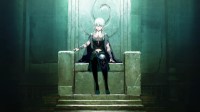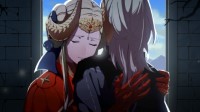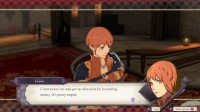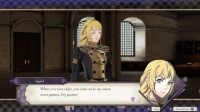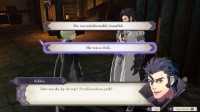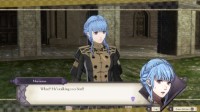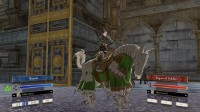Fire Emblem: Three Houses
Total Playtime: 273.5 Hours
Cindered Shadows: 9 Hours
Finished 31 December 2022.Finished all 4 routes, and the DLC (Cindered Shadows) - in order: CF, AM, VW, SS. Took me a couple of years playing on and off to do finally get around to all of them. Played F!Byleth and M!Byleth twice each; F!Byleth on CF and VW, M!Byleth on AM and SS. Romance was with Edelgard in CF, Ashe in AM, Marianne in VW, and Ingrid in SS (was also considering Shamir equally, but lost the coin flip so picked Ingrid, no regrets either way). Most playthroughs were done on Normal or Hard, and I did use Renown to some extent to kickstart Byleth but didn't use it for much else (no items, etc.). Cindered Shadows was only played once, on Normal. Of all of the campaigns, I probably enjoyed my first run (Crimson Flower) the most, but the others weren't bad. All statues are upgraded and Byleth has all the most broken skills instantly unlockable, but I don't really plan to play this game through again anytime soon.
I find it really interesting how this game is a return to the classic Fire Emblem games in some ways as a departure from the 3DS era, while adding in a similar number of mechanics that are completely new to the series, for better or worse. Overall, I think it's a great entry with a very large list of drawbacks from growing pains and failed experiments, but I ended up loving it anyway; not sure if I'd consider it my favorite in the series though. Aesthetically and graphically, it looks decent but still very outdated for its time; a number of the textures were meant to be more "realistic" but ultimately look 10-15 years old, and the color palette of this game is overwhelmingly dull, with lots of brown and grey shades. It's not quite at the level of Pokemon's horrible visuals, but they certainly aren't pretty.
The way the game's story was split into routes was incredibly ambitious, with more routes than each of the previous games. Similar to Fates, there are initially 3 routes that are chosen at the very beginning of the game, that determine pretty much the entire rest of the game - with the exception that the Black Eagles have another optional route split halfway through the game. However, unlike Fates which has 3 completely different sets of maps after the first ~5 tutorial missions, 3H has almost the exact same experience for the first half of the game, making it a huge pain to play through multiple routes (or god forbid, all 4 routes). Note that this "first half" is actually more than half of the game - the common route is longer than every one of the post-timeskip sections, especially CF, and has little to no difference other than your unit list - but you can recruit characters from other houses so that's a null point anyway. This makes the first half of the game feel incredibly slow, which is doubled by the fact that the pre-war missions don't really have much tension. Most of them feel like busywork story-wise, and tend to be short and simple. In contrast, the war chapters feel way too rushed; somehow, the continent was in an absolute stalemate for 5 years and Byleth is able to lead one faction to victory against the other 2 in less than 10 battles? The pacing of this game would have worked far better with a halved-size common route and double length war routes, which would move it closer to Fates in structure.
Outside of the route structure and plot pacing issues, I thought the story of 3H was very good - a night and day improvement from the muddled mess of Fates, while managing to have a much more complex story than Awakening and other older games in the series. I really liked that each of the warring states had motives beyond simply being evil, making the characters each more morally grey rather than the black-and-white perspective of almost every other FE. The justifiability of Edelgard's actions is still a major debate; and while a number of people continue to jump to conclusions about her being evil for the sake of it, there is still plenty of reasoning behind the actions that helped me understand how those events came to be (whether the judgment was ultimately sound or not). Unfortunately, this doesn't quite go for all of the factions - the Agarthians or whatever stupid name they go by is essentially the evil-for-no-reason group in this game, which is kinda sad, since the major factions and most of the plot dances around it very well.
Continuing onto the characters of this game - I liked them a lot! There was so much more effort put into each individual character than in previous games, though there was already some precedent for expanding interactions throughout the 3DS era, with deeper support conversations and character histories. The high-res illustrated art is essentially new to this game, since the 3DS was such low resolution; the character portraits in this game are beautiful in comparison, which continues to help in selling their personalities. And of course, the commitment to every single character being fully voice acted is great as well, though I think some of the lines could have easily been skipped. Part of me thinks that the additional audio files may have taken up so much space as to force the visuals to use a smaller set of textures, leading to the saminess. Nevertheless, the casting of the voice actors is spot-on for each character and really brings them all to life; the casting wasn't bad in previous games but the extensive voice work throughout this game is certainly a massive factor in this game's enduring success. However, there always has to be a drawback - Byleth feels SO out of place in this game as a silent character. It makes no sense at this point! Apparently (s)he is a professor, but you almost never hear him/her actually speak. At least the selected dialogues could have been voiced - so many of the supports with him/her feel so strange, because they all involve just one character talking to themselves about how great you are. It's not even a good opportunity to self-insert, either, since the personality is already defined; the dialogue choices don't do much to allow for different personalities, unlike games like Persona where you have a wider variety of options.
Speaking of the characters, the supports in this game don't follow Awakening and Fates with the weird child units anymore - this is one way that the game drew back some of the mechanics introduced in the 3DS era. They probably realized that the Fates explanation was stupid, and trying to shoehorn it into 3H would be nearly impossible, seeing as most of the characters are students and many of them aren't even adults in the early part of the game. Now, most supports level up only to A (some pairs only have C and B supports, no A); paired A supports get a paired ending card (if multiple A supports, then the closer bond wins). Byleth is unique here, with the ability to select one S support at the end of the game. There's no gameplay implication, but it does change an ending confessional/engagement scene to be with your favorite character. I really like the way that these were done in this game (to feel much less mechanized than previous games), and it fundamentally makes more sense for the pairings to come to fruition after the conclusion of a massive war. Unfortunately, there's still a little bit of whiplash when going through the supports; a lot of them are again about fairly mundane topics and storylines (like Ingrid eating meat a lot), which somehow turn romantic over the course of 2 more related conversations, just like the previous games. It's not perfect but maybe it'll feel better someday; I guess it's just hard to write up to 10-15 good romance storylines per character.
As mentioned in the first section, the gameplay of 3H feels like a return to form in some ways and a new evolution in others. The infinite-ammo mechanic of Fates has been reverted, and the simpler limited-use weapons with a definitive upgrade path (iron->steel->silver) is back. I always got a bit of an impression that the situational nature of Fates weapons wasn't a popular implementation for the entire series going forward, so this didn't really come as a surprise. Pair-ups have also been pretty much completely removed, though support bonuses for adjacent characters and similar situations are still in the game as usual, in a way that feels more natural and encourages players to actually use each character, rather than keeping them around as support bots. Deploy limits have been constrained somewhat though as a counterbalance, and maps generally feel a little bit smaller than before, with simpler win conditions and a lot of reused maps between missions. A couple of the other major changes are the addition of the battalions mechanic, which essentially make each unit on the field represent an entire army. Mechanically, battalions are basically just a stat-up backpack with an extra usable skill, which can really change the way the game is played. Another change which I'm more neutral about is that every character is able to switch to any class, aside from gender restrictions (which are far less frequent in this game), and each class can use any weapon; only some classes are able to use magic, however. While it makes it much easier to optimize characters and allows for really fun challenge runs, it's basically used by everybody to break the game by spamming wyverns everywhere. There's a few other combat-relevant changes but none significant enough to matter.
Probably the biggest change to the core gameplay loop is the introduction of the monastery, which is essentially a massive expansion of the party-building mechanics of previous games (ie. My Castle in Fates). It's fully-explorable hub with a bunch of random dialogue and side missions, shops and other events to gather support between missions. While it's really cool to explore the first few times, it quickly starts to get kind of annoying, honestly. The problem is that the hub is always the same throughout the entire game for each route. With one exception, there are no war camps and no opportunities to have an explorable area in each country, which makes the entire game feel samey. There aren't even any changes to the environment or weather throughout the different seasons, even though the game takes place across years of time. The game itself (in Japanese) is literally titled the Four Seasons, and yet that's never visible in game (not in any maps either, for the record). It also takes forever to load the map, so there's a lot of waiting for the load screens to finish whenever you travel around and stuff. I think I'd prefer the old menu system at the end of the day, or at least some kind of selectable option if the developers won't put in the time to make it shine. There's a ton of activities you can do to build skills and support levels between units (and Byleth), and also a professor section/minigame every week where you get to allocate study points for students to rank their skills up faster. These are cool, but I get the impression that they mostly exist to pad out the game, since the mission count and sizes in this game are significantly shorter than previous FEs (when played casually, that is).
With a lot of the other parts of this game feeling kind of iffy, this game has Xenoblade 2 syndrome, where pretty much every individual aspect is sort of a mixed bag, but the overall experience is far greater than the sum of its parts. The exception, which is also similar to XC2, is that this game's music is phenomenal, and one of the only parts of this game that I can't say anything bad about. The Switch is able to handle larger files and higher fidelity music, and they use every bit of that, including a soundtrack full to bursting with grand orchestral tracks for dramatic scenes and combat. There's a ton of musical variety in this game, and the climactic ending chapters of each route each have fittingly epic scores to accompany them. There's not much else to say - I still continue to regularly listen to the soundtrack because of how memorable it is.
Cindered Shadows
Cindered Shadows is the only major expansion to the game, adding a 7-chapter storyline and a group of 4 new characters that can be unlocked in the main game after the fact. It adds a good amount of variety to the game; maps have win conditions and layouts that force very interesting strategies with the new characters, each of which have a DLC-exclusive hybrid class. All characters are also class-locked, which makes this DLC significantly harder than the main game. I'd say CS Normal is between Base Normal/Hard (closer to Hard), and CS Hard is between Base Hard/Maddening from what I've seen. I've only played it once and don't really think I need to play it again, but it was a very worthy experience, and adds a couple of classes that are fantastic in the base game (Dark Falcon and Valkyrie). There's not much else to say; the DLC has another hub area of Abyss which has the same problems as the Monastery, and the rest of the ups and downs of combat apply here in equal measure.
